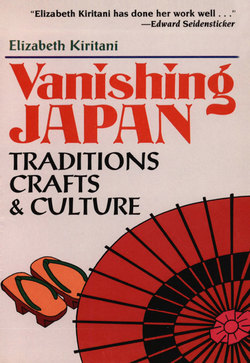Читать книгу Vanishing Japan - Elizabeth Kiritani - Страница 11
На сайте Литреса книга снята с продажи.
ОглавлениеPotato Vendors
Do you know the night ramen vendor's distinctive three-toned whistle? How about the knife sharpener's or the bamboo seller's special calls? Or the tofu man's whistle? They can still be heard in Tokyo's shitamachi (old, working-class neighborhoods). Certainly one call that everyone can recognize is the yakiimo man's. If you're lucky, you'll hear it coming from a cart pushed along the street and not from one of those trucks that fume up our environment. Who are these men who brave the cold to sell us those delicious potatoes? What do they do from late March to November when the season is over? Their life is not easy, and their tradition continues from centuries ago.
Monouri, or street vendors, were at work in the Heian Period (794-1185) although it wasn't until the Muromachi Period (fourteenth century) that they became a vital part of the economic system. They not only sold food, tools, toys, medicine, and small things for daily use, but some also bought used articles such as old clothes, umbrellas, and metal, and still others served as repairmen for knives, clogs, and the like. Some monouri specialized in seasonal goods such as decorations for the New Year, irises for Boy's Day, goldfish for summer, lanterns for Obon, and insects for children in the summer.
The life of the monouri was a hard one. During the Edo Period (1603-1868) selling became desperately competitive, and vendors began to don exotic costumes, use amusing and attention-getting calls, and even perform engaging antics in order to attract business.
The tojiname uri, for instance, who sold candies to children, wore Chinese clothes and a Chinese hat. He played a flute and drum, and delighted his young audience with dancing whenever he made a sale. The takarabune uri, active until the mid-Meiji Era, sold prints of the Seven Lucky Gods (shichifukujin) that you see here and there every New Year. People slept with these prints under their pillows to induce a lucky dream for the year. Soba vendors hung furin (chimes) on the carriers worn on their backs and jangled their way along the narrow streets. It must have been a noisy city even without the help of motorcycles and loudspeakers.
Although yakiimo (baked sweet potatoes) were popular in the Edo Period, they were sold only in stores—probably due to fire laws. Only boiled and steamed potatoes were sold by the street vendors. Today, in shitamachi, yakiimo are baked in pebbles that are heated by a wood-burning stove in the bottom of a wooden cart. Once fully cooked (after about one hour), they are raked out of the pebbles and placed in the adjacent warming compartment until they are sold.
My favorite yakiimo man, Mr. Nagao, is from Aomori. I came to know him because of his call. A veteran minyo and enka (traditional Japanese styles of singing) performer, his call is a distinct and beautiful distraction among the confusion of everyday noise. He is one of twelve men who are under his oyakata (boss) in the Ueno area. He says there are about ten bosses in Tokyo now, and each is in charge of a certain area. Mr. Nagao has been working my street for twenty winters. He sleeps in a nearby six-mat room that he shares with two older yakiimo men in their seventies, also from the Tohoku district.
Mr. Nagao is a rice farmer. After the harvest at the end of October, he comes to Tokyo to work until the end of March while his rice paddies are under snow. He sells sweet potatoes from 10:00 A.M. until 9 or 10:00 P.M., six days a week. He cooks for himself in his small room and, occasionally, goes out for drinks and karaoke at a local bar. Being away from home and eating the limited menu that he cooks are the hardest parts of his job, he says.
Just as in the Edo Period, he must rent his cart (2,500 yen a month) and buy potatoes (9,000 yen per 40 kilograms) from his oyakata. Things are tight now. As recently as 1981, he sometimes sold 100 kilograms of potatoes per day, but now he is lucky if he sells 20. At about 600 yen per kilogram, this doesn't leave much to take home after rent, food, and expenses. His most frequent customers, he says, are middle-aged women, and the best time of day for business is 3:00 P.M. The tall, noiseproof new buildings and the popularity of Western-style candy have reduced his sales.
At the end of last year he wasn't sure whether it would be worth his while to come again this season. So, one day in late October when we heard his distinctive cry, we smiled, knowing he was back. Whether he'll be back again next year is another question. Have you had a yakiimo lately?
